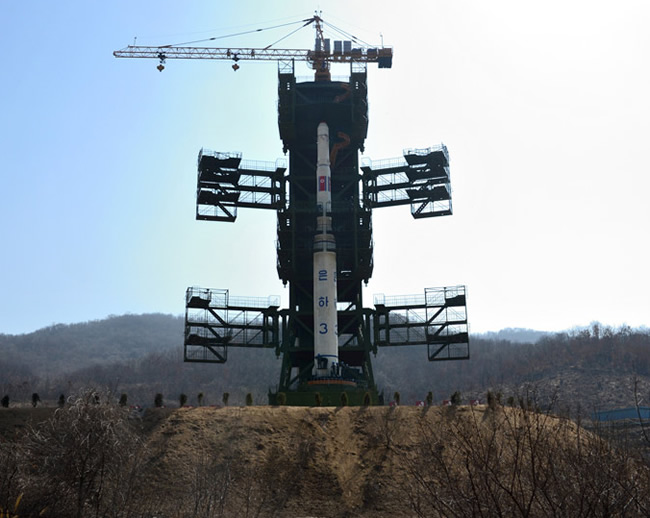
At a time when most of the world was led to believe that the Democratic People’s Republic of Korea (DPRK) was experiencing unknown technical problems with a three-stage Uhna-3 rocket scheduled to be launched between 10 and 29 December, Pyongyang fired the rocket at 9:49 AM Japan Standard Time (JST) on 12 December.
South Korean, Japanese, and international news sources reported that the rocket lifted-off from North Korea’s Sohae Space Center on the northwest coast and followed the flight path previously announced by the North.
Japan’s recently upgraded public warning system transmitted electronic cellphone messages announcing the launch at 9:58 AM JST. Japanese and South Korean Ministries of Defense have both confirmed the launch was executed.
According to statements made by South Korean Defense Ministry representative Kim Min-seok, the first warning of the launch came from a South Korean Aegis-equipped guided-missile destroyer stationed in the Yellow Sea. The destroyer’s radar was first to identify the rocket launch and this discovery came as quite a surprise.
Initial statements from South Korea’s Ministry of Defense expressed the possibility that this launch was successful in placing a satellite into Earth orbit. The US State Department issued a statement confirming the launch and announced that the situation would continue to be closely monitored.
Preliminary evidence indicates this rocket followed the anticipated flight path and traveled further than any of the North’s previous four launch efforts. Japanese government sources have been quoted as saying the rocket did pass over the Okinawan island of Ishigaki, but it is not known if any debris impacted Japanese soil.
North Korea’s Korean Central News Agency (KCNA), the official news outlet under Pyongyang’s control, announced that the Uhna-3 rocket was successfully launched from the Sohae launch site, and claimed that the Kwangmyongsong weather satellite entered Earth orbit as planned. Pyongyang has repeatedly claimed that this launch was designed to place the Kwangmyongsong satellite into a pole-to-pole Earth orbit to monitor weather trends and conditions.
Japan’s NHK television network broadcast a report stating that the first stage of the Uhna-3 rocket landed in waters west of the Korean Peninsula and the second stage crashed in the East China Sea only minutes after passing over the Okinawan island of Ishigaki. Additional rocket debris is reported as having landed in the sea approximately 185 miles east of the Philippines. Some news outlets are reporting that the rocket may have traveled as far as 1,600 to 1,800 miles from the launch site.
Despite Pyongyang’s claims that the launch was successful, there has been no independent confirmation that the third stage actually lifted the satellite into orbit.
Japanese, South Korean, and US forces in the area were placed in an alert status about a week before the launch, but no attempts were made to shoot-down the rocket.
South Korean and Japanese political leaders convened emergency high-level security meetings to analyze the preliminary data now available and to lay the foundation for an appropriate response to this launch.
North Korean announcements on 10 December that technicians had identified “deficiencies” in the rocket’s first stage that would delay the launch received widespread notice and convinced most analysts that a launch could not be undertaken for at least one more week at the earliest. Technical analysis of satellite imagery and reports from intelligence agents appeared to confirm that Pyongyang was disassembling the rocket further reinforcing the belief that the launch would be delayed for a significant period of time.
It’s now obvious that the North was very successful in duping the best and brightest subject experts and was also able to continue launch preparations without being detected by some of the finest satellite resources in operation. The launch was, to put it mildly, a shock to most devout observers intent on monitoring Pyongyang’s activities. This alone is quite a coup for the North.
The reclusive North is under a UN ban that prohibits the nation from engaging in missile and nuclear tests. UN sanctions were imposed on Pyongyang in 2006 and 2009 in response to the North’s continued efforts, and two failed tests, to develop a nuclear capability.
North Korea has tried for many years to succeed in launching a multi-stage rocket into space. This launch was the fifth such attempt since 1998. The previous four attempts were abject failures, the most recent on 13 April of this year.
Some reputable analysts believe that Kim Jong-un’s hold on power is not as firm as he and the Party’s leadership would like. This launch is seen by many as an attempt to bolster support for Kim in an effort to solidify his hold on the nation.
A successful launch this time would go far in polishing Kim’s image and in quelling any dissent that might have been brewing under the surface. A failure this time could prove to be a disaster for Kim and might disrupt his efforts at unifying the North’s leadership under his control.
Regardless of the success or failure of this launch, Pyongyang can expect the United Nations to make a concerted effort to impose additional sanctions on the regime at a time when the North is desperately in need of international assistance with food supplies, medical assistance, and humanitarian support for a humble population of starving peasant farmers and struggling workers.
















